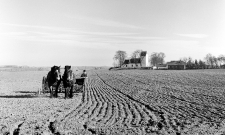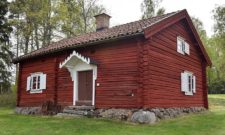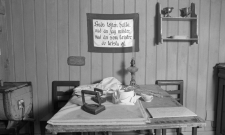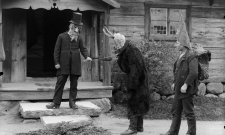Thoughts from the past, Texter
Memories of heathland belief and cult in Norrlandic place names

May
How long have Thor, Odin, Seed and other Old Norse gods been worshipped in Norrland? Johan Nordlander's (1853 - 1934) study of place names in Gästrikland, Hälsingland, Medelpad, Ångermanland and Jämtland gives us answers about the age of the Swedish settlements in the north. Text from the journal Ymer, issue 28 (1908).
In 1881 the author published an essay with the same title as the one above in the programme of the Härnösand elementary school. It was prompted by the statement, common at the time, that place names recalling the gods and religious practices of our pagan ancestors were "very rare" north of the Dalälfven. And there it was shown that the northern limit of these names was not the Dalälfven but the Ångermanälfven, a result which stands firm if we say instead of this river its valley.
In the time between 1881 and the present, however, local-name research has made great progress, and much of the content of the essay referred to we should now wish to have excluded or dealt with in another way. But there is also not so little that should be added. Since, in addition, the said essay has never been available in bookshops, this should be reason enough to publish a revised and enlarged edition of it.
What, however, more than anything else has prompted us to revisit the subject is an opinion by the well-known Finnish linguist Ralf Saxén. In an essay on "The Age of the Swedish Population in Finland, as Illustrated by Place Names",1 he denies that the names given by us from Norrland testify to any pagan gods. The only name which, in his opinion, could come into question would be Torsåker; but even this is not considered certain, and the Honourable Author sums up his opinion in the following words: In any case, however, we must consider it probable that pagan god-names do not occur in the Norse place-names.
This assertion we shall here seek to refute.
When pagan god-names were combined with another word and together with this formed a place-name, the reason for this was not always one and the same. Often, the combination was due to the fact that a place was consecrated to a certain god and was therefore quite naturally named after him. When we find the name Frösvi in Södermanland, Närke, Västmanland, Väster- and Östergötland and Småland, this has of course arisen from the fact that there has been a holy place (vi, ve), which was dedicated to the god Seed.
But even for more incidental reasons, places were named after gods. Among the Norwegians who colonized Iceland was one named Torulf, who, according to the Landnamabokens, was a "great blotman and believed in Thor". On his ship coming to the vicinity of the island, he threw the high-seaters he had brought into the sea with the intention of settling down, where they floated ashore. On one was carved the image of Thor, and the pious pagan uttered with a play on words, that Tor would come ashore in the place where he wanted, that Torulf would build and live. He also vowed to dedicate all his land to Thor and to name it after him. The pillar with Thor's image was found on a nose, which was called Torsnäs, which name was also extended to the whole of the area occupied. A river, which bounded it on one side, was given the name Torså. - Another land-name man named Asbjorn also dedicated his taken land to the same god and called it Torsmark.
But what was customary among the Norwegians who emigrated to Iceland, was probably also customary on this side of Cologne. We may therefore safely assume that the same principles were followed in naming here.
If we look at the names of the parishes and villages in the particular landscapes of Norrland, we find the following gods named in them.
GREECE has two related names, both recalling the god Thor. These are the parish name Torsåker, Thorsakir 1314, and a meadow in Thorsvalle 1443, which according to Thulin p. 11 2 mentioned as donated to Valbo church. The former name must not be thought of as originally referring to the whole parish; it probably first belonged to a smaller area, after which, as was the case with the aforementioned Torsnäs, it was extended to a larger one. The latter is pronounced Tωrsvall'n (the type ω distinguishes the final o-sound.) and belongs to some peat farms right next to Valbo church.
In HEALINGLAND it is preferably the god Seed, who reveals himself in the place names. Those who belong here are:
- Frösten, village in Jättendal near the church, Frosts 1582, Ffröstuna 1543, 45, 47, Frozen Lwndha 1535.
- Frölland, village in Högs s:n, FRöland 1535.
- Frölland, village in Rogsta s:n, FRöland 1535.
- Onsäng, village in Ljusdals s:n, Oensenge 1546, Wednesday 1543.
There are also some names which seem to belong here; they are: Toröö, an island in Lake Täfran in Järfsö; Thorsås, a mountain in Hassela, and Thorsberget not far from Trönö church, according to R. Dybeck.3
Even in MEDELPAD the same god is preferably called in the names of the villages. We have:
- Seedland in Timrå, Ffrölandh 1535.
- Frötuna in Ljustorp, Frötunom 1409.
- Frosts on Alnön, Ffrossetther 1535.
- Torsiö was 1543 an outland in Njurunda; Törslö tiern mentioned in 1559.
East of Sotsjön in Hafverö s:n is recorded on a map of the year 1724 in the General Land Survey Office (L. M. K.) a lake Torösiön. NW of Borgsjö and just on the border towards Hafverö is the small lake Lake Tor. On the same map of 1724 this is also called Torssiön and a mountain nearby Torsberge. The river from the lake is called Torsbäcken, and at its mouth in Ljungan there is a place called Gate pine. This last name, otherwise unknown in Norrland, is, as far as the later ranks are concerned, a counterpart to the Norwegian or Skœphœimumi.e. one of the ancient names containing the noun home.4 In Hülpher's description of Medelpad there is page. 52 about Torp noted: A place west of the church is still called Torsåker. Also worth mentioning is Lake Torringen on the border between Borgsjö and Jämtland, Toringen Lacus on the said map of 1724.5
Yet the name of the god Fro is included in The Frogs, 1724 listed as a small lake in Attmar.
After the coast, the place-names composed of the names of the gods extend as far as ÅNGERMANLAND, and if one excludes some names on the north bank of the Ångermanälfven and thirteen a little further north, then one can say, that the said river is the border of these names in the north. The names occurring here are as follows:
Fröstdal, a village in Nätra, also called Fröstad, written by the priest in the register of tithes Frösdal 1560, Fröss dall 1559, Fröszdall 1557.
Fröstland, village in Bjärtrå, Ffrösland 1542.
Fröland, village in Säbrå, pronounced Floran, Ffröland 1542.
Fröstvik, village in Nordingrå, Frösswijk 1535.
Torsåker, parish, Thorsakir 1314. The name may have originally belonged to a village Torsåker about 28 seland, in 1545 taken up after Öster-Aspby, but has since been transferred to the parish.
Ullånger, a parish, Uldanger 1316, contains the name of the god Ull.
Some other names include the name of the god Thor, namely:
- Torsberget in Vibyggerå with tales of stones thrown against it by giants;
- Torsbäcken in Nordmaling and Torså in Arnäs,
- Torsbäcken in Liden with Torsbäckörn in the Ångerman River.
- Torsön (or Notön) in Nämdforsen in the same parish, known for the existing rock carvings there, is perhaps identical to the newly mentioned "ören".
- A map of 1745 in L. M. K. has in Nora a bay of Gånsviksfjärden with the name Torsundet.
JEMMTLANDS names of this kind are:
- Torvalla, village in Brunflo, in Torwallom 1546, Peat whale 1508.
- A land after Stamnäs in Brunflo was written Gate length 1566, Thor's Bed 1567.
- Odensala, village in Brunflo, Odhinsal 1410.
- Frösön, the big island in Lake Storsjön, Frøsø 1314, 16.
- Norderön, a smaller island in the same lake, Nærdrö 1438, contains the name of the god Njord.
- According to a map of 1766 in L. M. K., a bay of Valsjön at the top of the Hårkan valley has the name Torsvika, and this has the island Torsviköa. In Åre s:n hear Fröå, Fröådalen and Seed mine all together.
That the parish and village names here cited have a god-name as their first constituent, I think so clear that there can be no doubt.
Yet there are some place names, which contain the word god. Already a long time ago M. Fr. Lundgren6 attributed a Gudzio 1399 in Västmanland, now Gusjö, to pagan times. This name also appears in Ångermanland, where in 1535 in Säbrå tingslag we find the village Gussijö. This has since been divided into several villages, and the name has come to designate, as it did originally, only the lake itself. It was written Gudz siön 1559 and now Gussjön. The lake, which lies far from the coast, is named after the Riddle River, Gådhån 1558, which again has borrowed its name from the village of Gådeå, situated at the mouth of the river, Riddle 1555. In this journal, 1907 edition,7 we expressed the presumption that there was here a composition of god and wine (meadow) and that an older form of the name should have been called Gods, a shape, which is part of the name of the village and the fish location Godensviken 1559, now Gånsvik. Such a form has also been found later. By the river is also this
aforementioned village Seedland.
A few miles west of this Gussjö is on the border between Medelpad and Jämtland a large lake, which also has the name Gussjön, from which the name Gussjölandet Gåda, village in Ramsjö in Hälsingland, seems to be of the same origin. On the oldest maps in L. M. K. the village is written Guda, a mountain next to it Guda Berg and a lake Gussiön with Gussiö cottage.
To these belong also the four names occurring in Medelpad and Ångermanland Helgum (i.e. holy + home), quoted in this journal, 1907 edition, as well as Hällsjö in Dals s:n in Ångermanland, Helgesiö tresk 1560. On pagan faith also referred to the names Lake Vigd in Liden in Ångermanland, Wigde swamp 1559, and the river coming from it Vigda (cf. the verb viga). The same river name also occurs in Norway.
Several other place-names could be cited here, but as we only see completeness in the matter of parish and village names, we can content ourselves with the evidence already presented.
That it is really pagan god-names which are included in the place-names here cited, we consider, as said, beyond all doubt.
Should anyone nevertheless dispute the matter, we refer to a fact which is quite convincing. If pagan gods have been worshipped in the regions mentioned, traces of pagan worship should also be found in their place-names. And they are to be found precisely in the regions here treated, but not further north.
We have in GREECE separate villages Vij, namely in Torsåker, Ockelbo and Hamrånge, all written We 1543, whereunto come Vibol in Hedesunda, Sy. diplomatarium 1346, and Vibol in Ofvansjö according to a 1603 copy of a document from 1293, see Thulin p. 134.
HEALINGLAND has five villages with the same name, namely in Tuna, Tröne, Ljusdal, Delsbo and Idenor, all written We in the 1540s. Court, pagan temple, included in the village names Håf in Arbrå and Söderala, both written Hoff 1535.
MEDELPAD owns two villages, which contain courtnamely Court in Selånger, Hoff 1535, and Hofvid on Alnön, Hoff 1535, Hoffue 1560, occasionally also Hofuet; and two villages Vii, one on Alnön, We 1535, the second in Tuna, We 1480. The latter name often appears in the best form; e.g. in the fishing account for 1560, where it is called: at Wiedtt and immediately thereafter: at Tuna just below Wied. This includes the village of Vissland in Torp, Vislandet 1418, i Wislandom 1438, Vis- and Wüslandh, tithe accounts for 1557, 49.
ÅNGERMANLAND has names of both kinds. Hoff was in 1542 a village on Härnön, but was placed under Härnösand; its property is still called Hofsjorden and after it has Hofsgatan in the city its name. Håff was 1555 a church land in Torsåker, where Hofzåkeren and Hofzänget mentioned in the church's inventory. - In addition, there are in the region two compositions of court and winenamely Höfven in Resele, Höfwene 1559, 60, Courtship 1557, 58 in the register of tithes, and Courtship 1569 in Nora, 9 seland of land, belonging to the priest's residence there. Two places Court missing in my notes, namely a new building with this name in Anundsjö and the farmhouse Hoff in Hägdånger, 1592, see Thulin II: 159. At least the former is of more recent date. We-names this landscape has only a, mention- Viätt (pronounced in accordance with the scripture), Wiett 1583, Viet 1589 tithe register, Wietth 1542, i.e. best form of Vi. The village is situated in Styrnäs parish on the north bank of the Ångermanälven; the name is the northernmost of its kind in Sweden.
At last we come toL JEMTLAND. While We-names here are represented by only anamely We in Nose 1439, are Hofven no less than sex. These are: Hoff 1611 in Ås, Hoff 1568 in Norderön, Hoff 1471 in Alsen, Hoff kirkio 1408 in Hackås, in Hofui 1428 on Frösön and a manor in Lit Hoffzput 1568, Hoffz. visit 1570.
In the other regions of Norrland, Härjedalen and Västerbotten, one searches in vain for some village names, which contain either the names of pagan gods or indicate pagan worship. But with regard to the other provinces, we hope that the existence of these place names will no longer be denied. That the valley of the Ångermanälf is, by and large, their northern boundary, should be established.
If we look at the gods mentioned in the different regions, we find a certain diversity. The two names in Gästrikland recall the god Tor, according to Adam of Bremen the most powerful deity of the Swedes. The predominant name in Hälsingland, Medelpad and Ångermanland, however, is Seed, also a god worshipped by the Swedes with special devotion. The images of Thor and Frodo were also found in the Uppsala temple along with those of Odin. In Jämtland the variety is greatest: there are mentioned Tor, Oden, Seed and Njord. Remarkably, Odin appears only here and only once. Whether this alternation is the work of chance, or whether it is due to provincial differences, we cannot say.
How the gods and places of worship are distributed among the five regions, we show here with a small table. We have only the names of parishes and villages and other old and certain names of lands; we count as places of worship not only those called Hof and Vi, but also those with the name Helgum.
| Godaname | Place of worship | |
| Gästrikland | 2 | 5 |
| Hälsingland | 4 | 7 |
| Medelpad | 4 | 6 |
| Ångermanland | 6 | 8 |
| Jämtland | 5 | 7 |
The names with which we are here concerned are of interest in many respects. First of all, they testify that these regions were inhabited at a time when the gods named in them were worshipped in the North, and show that we had the same population there as in Svealand. This is not a new thing; we know it from ancient finds in the earth as well as from wine- and home-names in the same landscape. If we compare the occurrence of the religious names with the distribution of the later names, the correspondence is very great. Of the former, five occur north of the Ångerman River, and the northernmost in the parish of Nätra; the latter also become thinly sown after this region, and in the Örnsköldsvik region they virtually cease to exist. Up after the Ångermanälfven extend the court names with Höfven as far as Resele or to a mile below Nämdforsen, which has rock carvings, now found to date from the Bronze Age.
When the names of religions are considered for younger than wine- and home-names, it is perhaps surprising that the former do not extend as far northward along the coast as the latter, or even further. D:r Saxén would like to see in this a proof of his opinion on the low age of the northern surnames. "If Rygh's dating of these is correct," he says, "it must be assumed that home-names, for some unknown reason, have again come into honour in Norrland, and have persisted here still longer, after this type of name has fallen out of use in other parts of Scandinavia." The difference, however, is so slight as not to justify any conclusion in the direction mentioned. Moreover, the rule that the church should stand in the middle of the village was probably applied even at the remote period in question, and if one departed from it, it was probably in such a way that the place of worship came to be nearer to the area from which the colonization had started than to the opposite part of the area.
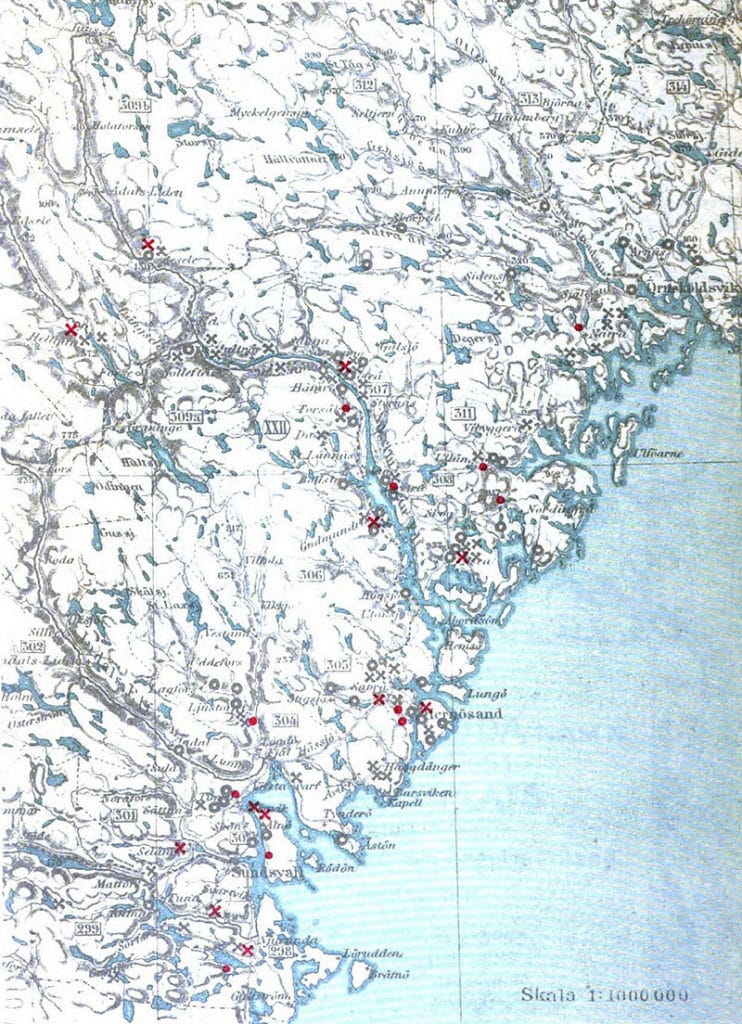
On the accompanying map we marked a year ago wine- and home-names in Medelpad, Ångermanland and Jämtland and now add the religious names in the same regions. Even a cursory glance shows that where the former appear in groups, some religious name also occurs. Consider the shores of Alnö Sound and the valley of Ljustorp in Medelpad, Härnön, Säbrå, Nora, Nordingrå, Gudmundrå and Boteå parishes in Ångermanland, and Frösön or generally the eastern shore of Lake Storsjön in Jämtland.
The religious names, however, are not only of cultural and historical interest, but deserve attention in another respect as well. They help us to date several old, composite place-names. With regard to Norway, Rygh says that the names of -country to a very large extent belong to the Viking Age. When we now find in the area in question no less than five village names ending in (Seed) land, it is indisputable that these names in Norrland have the same age. This does not prevent, however, that combinations with -country may sometimes be quite young, e.g. the formation occurring in Norrland and Dalarna Out-of-country. That names of -tun (farmyard; enclosed place) and -säter (dwelling) have great age, is already known; it is also confirmed here, as both words are compounded with the name of the god Fro.
Sources
- Uti Finska Fornminnesföreningens Tidskrift XXI, n:o 3.
- The ecclesiastical forests, I. Stockholm 1904.
- Note in his manuscript in the possession of the Academy of Literature.
- Rygh, Norske Gaardnavne, I: 355.
- This lake is identical to þorhogs eid in Jamta skoge, which is mentioned around 1273 as a border mark between Medelpad and Jämtland; Rydberg, Sveriges traktater, I.
- Linguistic certificates of pagan belief in God in Sweden, p. 11, Gothenburg 1878.
- From the essay "On Norrland's ancient cultural settlement".
Subscribe to YouTube:
If you appreciate Allmogens independent work to portray our fine Swedish history and Nordic culture, you are welcome to buy something nice in the shop or support us with a voluntary donation. Thank you in advance!
Support Allmogens via Swish: 123 258 97 29
Support Allmogens by becoming a member
Support Allmogens in your will
Historical maps of Jämtland
Our wall maps are carefully restored, centuries-old maps that are reprinted in Ångermanland on matte, age-resistant, museum-quality premium paper. 1% of the proceeds go directly back to cultural heritage!


